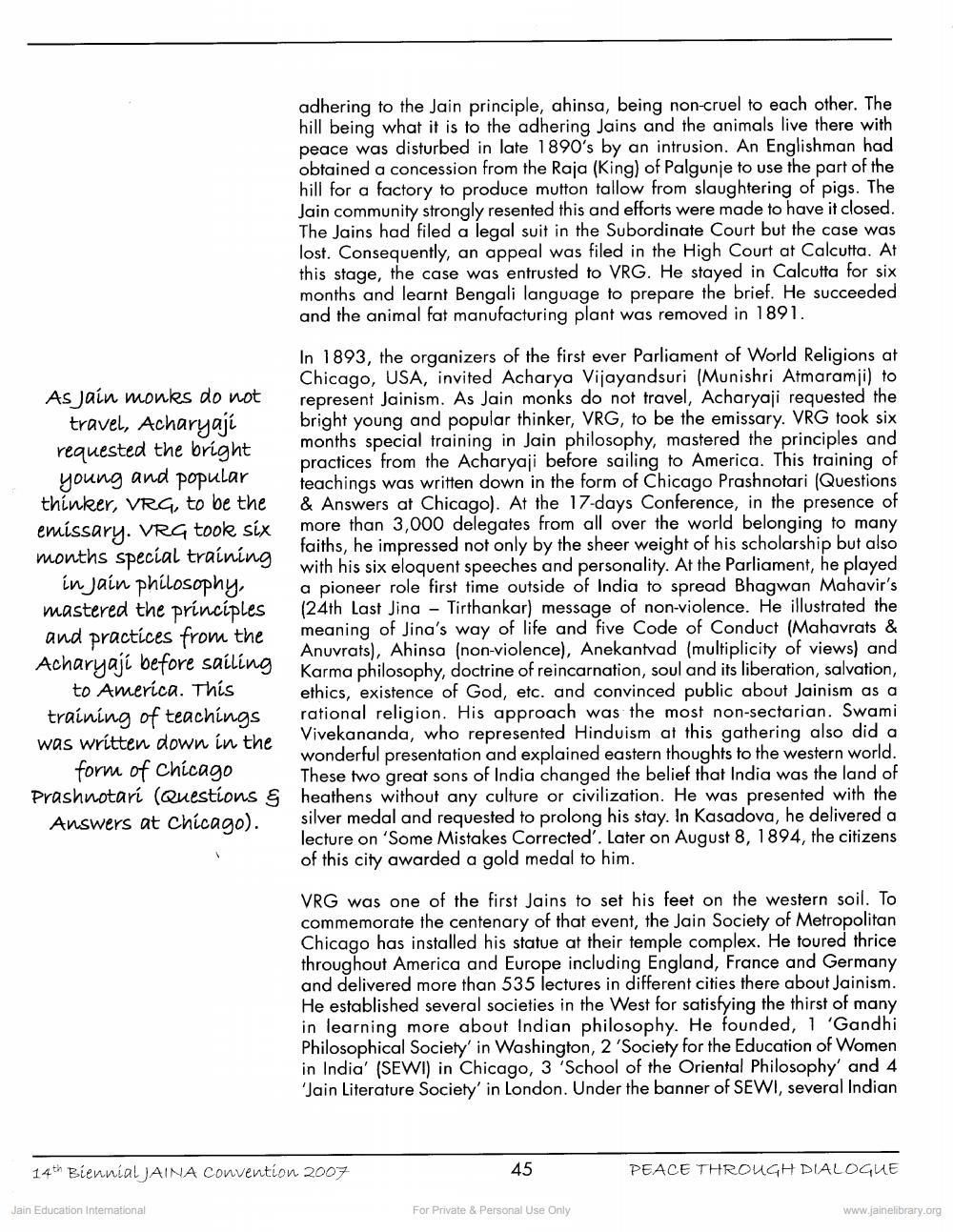________________
adhering to the Jain principle, ahinsa, being non-cruel to each other. The hill being what it is to the adhering Jains and the animals live there with peace was disturbed in late 1890's by an intrusion. An Englishman had obtained a concession from the Raja (King) of Palgunje to use the part of the hill for a factory to produce mutton tallow from slaughtering of pigs. The Jain community strongly resented this and efforts were made to have it closed. The Jains had filed a legal suit in the Subordinate Court but the case was lost. Consequently, an appeal was filed in the High Court at Calcutta. At this stage, the case was entrusted to VRG. He stayed in Calcutta for six months and learnt Bengali language to prepare the brief. He succeeded and the animal fat manufacturing plant was removed in 1891.
As Jain monks do not
travel, Acharyaji requested the bright
young and popular thinker, VRG, to be the emissary. VRG took six months special training
in Jain philosophy, mastered the principles and practices from the Acharyaji before sailing
to America. This training of teachings was written down in the
form of Chicago Prashnotari (Questions &
Answers at Chicago).
In 1893, the organizers of the first ever Parliament of World Religions at Chicago, USA, invited Acharya Vijayandsuri (Munishri Atmaramji) to represent Jainism. As Jain monks do not travel, Acharyaji requested the bright young and popular thinker, VRG, to be the emissary. VRG took six months special training in Jain philosophy, mastered the principles and practices from the Acharyaji before sailing to America. This training of teachings was written down in the form of Chicago Prashnotari (Questions & Answers at Chicago). At the 17-days Conference, in the presence of more than 3,000 delegates from all over the world belonging to many faiths, he impressed not only by the sheer weight of his scholarship but also with his six eloquent speeches and personality. At the Parliament, he played a pioneer role first time outside of India to spread Bhagwan Mahavir's (24th Last Jina - Tirthankar) message of non-violence. He illustrated the meaning of Jina's way of life and five Code of Conduct (Mahavrats & Anuvrats), Ahinsa (non-violence), Anekantvad (multiplicity of views) and Karma philosophy, doctrine of reincarnation, soul and its liberation, salvation, ethics, existence of God, etc. and convinced public about Jainism as a rational religion. His approach was the most non-sectarian. Swami Vivekananda, who represented Hinduism at this gathering also did a wonderful presentation and explained eastern thoughts to the western world. These two great sons of India changed the belief that India was the land of heathens without any culture or civilization. He was presented with the silver medal and requested to prolong his stay. In Kasadova, he delivered a lecture on 'Some Mistakes Corrected'. Later on August 8, 1894, the citizens of this city awarded a gold medal to him.
VRG was one of the first Jains to set his feet on the western soil. To commemorate the centenary of that event, the Jain Society of Metropolitan Chicago has installed his statue at their temple complex. He toured thrice throughout America and Europe including England, France and Germany and delivered more than 535 lectures in different cities there about Jainism. He established several societies in the West for satisfying the thirst of many in learning more about Indian philosophy. He founded, 1 'Gandhi Philosophical Society' in Washington, 2 'Society for the Education of Women in India' (SEWI) in Chicago, 3 'School of the Oriental Philosophy' and 4 Jain Literature Society' in London. Under the banner of SEWI, several Indian
14th Biennial JAINA Convention 2007
45
PEACE THROUGH DIALOGUE
Jain Education Interational
For Private & Personal Use Only
www.jainelibrary.org




